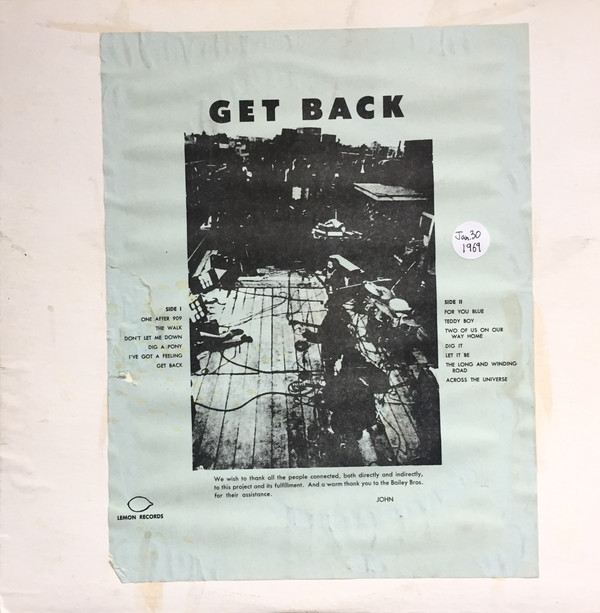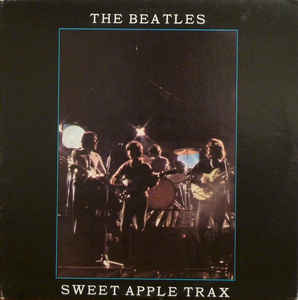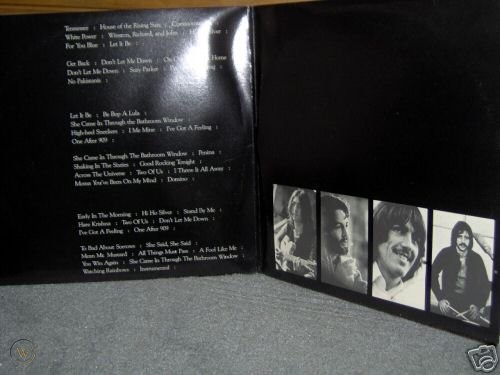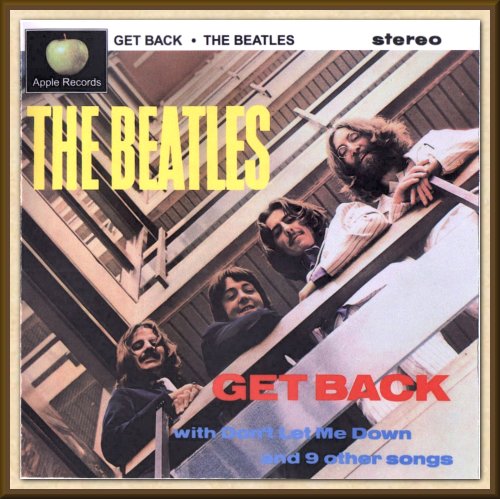A Slightly Personal History of the "Get
Back/Let it Be" Project
by Rip Rense
|

The original "Get Back" bootleg, on "Lemon Records,"
that appeared in September, 1969, eight months
before "Let it Be." |
There must be an adage along the lines
of: one little thing goes wrong, a million follow. You
know, one mouse nibbles, the whole cheese goes to hell.
Something like that.
That is more or less the
story of the “Get Back/Let it Be” project. In this case, the
“one little thing” was George Martin bowing out as supervising
producer, I would argue, and appointing young Glyn Johns to take over. Had Martin remained, and the band followed his
solid guidance, there likely would have been: a fine new album,
a TV special about its making, and at least one live concert.
Or, at minimum, a fine
new album.
Instead there have been
four albums of the sessions---five if you include the 2009 remaster---countless bootlegs, one largely
depressing motion picture, a brief but grand performance on a
rooftop, and, at long long long last, a brilliant
documentary: “The Beatles: Get Back.” (Score one for the
cheese.)
Only original fans,
probably, can appreciate exactly how involved, tangled, criminal
(literally), exasperating, and downright cuckoo the whole “Get
Back/Let it Be” saga is, because they lived through it. Over
five decades. Talk about: you and
I have memories longer than the road that stretches out ahead. .
.
As for the rest of
you, well, parting the pot-scented swirling mists of time. . .
When I first heard of the
project---through this-or-that friend or magazine, probably in
January or February of 1969---I perked up. Hell, the Vietnam,
assassination-weary world perked up. The Beatles were going to
play and record live, with no overdubs, all new songs, and a show
(or even tour?) to follow---after having seemingly retired to
the recording studio in 1966. The return of Christ, to recall
Lennon’s infamous controversy, might not have been competitive.
Suddenly, there they were
on the tube again---the first time since scruffy “new Beatles”
appeared via Michael Lindsay-Hogg’s filmed performances of “Hey
Jude/Revolution” in the summer of ’68. Promo films of their
terrific new single, “Get Back” and “Don’t Let Me Down,”
performed whimsically on their Apple HQ rooftop, showed up
on, of all things improbable, The Glen Campbell Show,
April 30, 1969. (Also filmed by Lindsay-Hogg.) The music was
spare, unlike any previous Beatles work, signaling yet another
vast stylistic change from this most chameleon of musical
aggregations. Was this country? Blues? Rock? Country-rock-blues?
Would the whole forthcoming album be like this? Was this the new
new Beatles? And who on earth was the antic keyboardist
credited on the single, and playing on the roof with them, Billy
Preston? Well, the coming album would answer all these
questions. . .
But then. .
.nothing.
There was no new
album, following up on the single. It didn’t turn up in the bins of The
House of Sight and Sound or
Wallach’s Music City---the big L.A. chains at
the time (Licorice Pizza opened in '69, and Tower and The Wherehouse came
along about a year later.) Instead, along came another handsome
black-sleeved “The Beatles on Apple” single, only a month later, and it was
an odd one: the slapdash “The Ballad of John and Yoko,” reportedly featuring
only John and Paul, with a B-side of Harrison’s peculiar shuffle, “Old Brown
Shoe.”
And again. . .not another
peep, no sign of an album.
The mystery remained for
five long months, only to be compounded in late September of ’69, when, at
long last, a brand new Beatles album did appear, but not the reported “Get
Back,” and with little fanfare. I stumbled across a British import pressing
of it in The House of Sight and Sound in Marina del Rey, California, one
afternoon after 11th grade, just sitting there quietly in the bin
marked "The Beatles," no trumpets, no parades, no dancing donkeys. (I
literally ran two miles home, stole $3.50 in change from my parents’
bedroom, ran back to buy it just before closing time.) This, of course, was
the superb, polished masterpiece, “Abbey Road,” a more-than-welcome
contribution to a wounded world.
So. . .
|

"Sweet Apple Trax," the first major bootleg of "Get Back/Let it
Be" rehearsals. Two LPs. |
Had “Get Back” been
junked? Had it even been recorded? None of the songs on the previous two
singles were on "Abbey Road," and there was no word about a “Get Back”
session LP in the offing. Then, in 1970, something downright freaky
happened---a full year after the project reportedly took place. No, another
new Beatles album did not slip quietly into stores---rather, it slipped
quietly into swap meets, “head shops,” radio stations, the backs of used
bookstores.
It seemed that acetates
of early versions of most of the “Get Back” songs, plus jam-snippets such as
“The Walk” and “Dig It”---all supposedly owned by Lennon---had leaked,
whether accidentally or deliberately, to WBCN in Boston, which promptly
played them on the air. The date was Sept. 22. Tape recorders whirred.
Suddenly, somewhere around 20,000 crudely packaged albums, referred to as
bootlegs---taken from the WBCN radio broadcast (and other
stations)---began circulating with various titles: “Kum Back,” “Get Back to
Toronto,” and “Get Back.” White covers stamped with titles, or with crudely printed
one-sheet pasted on.
One afternoon, as I rode a city
bus home from Venice High School, in Los Angeles, this nice neighbor kid
asked me if I’d heard the new Beatles album. I thought he meant
“Abbey Road." No, no, he said---it was kind of a secret message from
The Beatles, a secret album. At sixteen, I certainly had no
idea what this meant, but I figured The Beatles were up to something weird
and wonderful, as usual. Well, the kid kindly loaned me his copy of the
disc, “Get Back,” on “Lemon Records,” and for a few weeks I played it
several times a day, in utter bafflement. The songs mostly sounded
unfinished, or had false starts, even (gasp) partially completed lyrics, and
the sound quality was less than optimum. The songs were good---this was The
Beatles, after all---but. . .kind of informal, different. After the
high-tech sheen of “Abbey Road,” this was jarring---and a puzzle that was
not (partially) solved until March 1, 1970---when, suddenly, there were The
Beatles again, appearing on, of all things full-circle, The Ed Sullivan
Show! Shades of 1964! Except these were the pre-“Abbey Road” Beatles,
which was discombobulating, and they appeared via filmed performances of
two new tunes,“Two of Us” and “Let it Be”---year-old songs, embryonic
versions of which had appeared on the bootlegs!
Everyone wondered: now
was the “Get Back” album finally coming out?
Before that
question was answered, however, there came a 9.0 culture quake. Paul had
left The Beatles. (We know now that Lennon had left the group the preceding
fall, but had asked the other Beatles to keep it quiet.) As I wrote, decades
later, in my roman a clef novel about growing up, “The Oaks:”
Everything was different now, less. The world was hollow. It
was as if all the grass had retracted, or all dogs and cats had run away, as
if basketball had never been invented, or poetry, or ice cream, or
primroses. How could you go about business as usual? The wedding ring
bounced and rolled into the sewer, the composer died before the symphony was
finished, the Mona Lisa frowned, the cake fell, the house burned down.
Everything was false, echoey. Beethoven a plagiarist, your mother
moonlighted as a hooker, the dog didn’t really like chasing the ball, the
rainbow went black-and-white, Muhammad Ali turned out to be a woman.

The so-called "Black Album," the second major
bootleg of "Get Back/Let it Be" rehearsals. Two LPs,
with package imitating the "white album," complete with embossed
"The Beatles" and folded poster inside. |
With this
pull-the-rug-out-from-under-you news, the “Get Back” matter receded in
importance, became almost moot. Right in the middle of a wave of new
Beatles album anticipation, there were. . .no more Beatles? Think:
waiting for a badly needed paycheck, rushing to the mailbox, and finding an
empty envelope.
Enter the walking
manifestation of musical irony, the Mefistofeles of this opera: Phil Spector.
On May 8, 1970, at long last, the mysterious, official
“Get Back” album, retitled “Let it Be” for no apparent reason, and produced
not by George Martin, but “re-produced for disc," whatever that meant, by
Mr. “Wall of Sound,” was released---cue final Sgt. Pepper chord. With
an embarrassingly plain black cover and the four almost blurry stills---the
only Beatles album to show the group as individuals---the LP would be
forever tainted with poignancy, disappointment, dismay, heartbreak over the
band’s ugly dissolution. Talk about spoiling the party.
This proved even more the
case for the “Let it Be” movie by Lindsay-Hogg, released only a few days
later. To put it charitably, his reduction of somewhere near sixty hours of
footage into an hour and 21 minutes was dreary, mostly conveying: acrimony,
hostility, lethargy, argument. The tone, if not intended angle, was one of
impending Beatles doom. Making matters worse, the film had been blown up
from 16mm to a grainy, unpleasant looking 35mm, so it came across---like the
“Get Back” bootlegs---as kind of half-assed. There on the big screen,
instead of the jovial “Magical Mystery Tour” Beatles (a better looking
film), or the down-to-earth “Hey Jude” Beatles, were. . .disinterested,
passive-aggressive Lennon, domineering, pretentious McCartney, disgusted,
simmering Harrison, and hangdog Ringo. “Let it Be,” the movie and album,
became the group’s de facto funeral, despite the (yawn) Academy Award for
“best score” that came the following year.
(And yes, I again
stumbled across the album at the House of Sight and Sound , not expecting to
find anything. This was the original, imported boxed set version, with a
huge book inside, documenting the sessions. I believe the asking price was
about five bucks---enormous, at the time. Once more, I rushed home to steal
money, but this time, when I returned, the album had been bought. I'm still
miffed! Today it goes on eBay anywhere from $500 to $1000, and up.)
To make things even
stranger, if this was possible, the expressed goal of the album being
live, with no overdubs, was tossed out by Spector, who infamously added
(very good) Richard Hewson orchestral scores and (very corny, saccharine)
ladies’ choirs to “The Long and Winding Road” and “Across the Universe”
(with lesser intrusion on “I Me Mine.”) I have this in common with
McCartney: I hated these productions at first listen. These were supposed to
be “chamber music Beatles,” without adornment. The mountain of musical
flowers heaped on “The Long And Winding Road,” it turned out, had even a
been a deciding factor in McCartney announcing his departure from the group.
He had lost control of his own work, after all. In sum, “Let it Be,” while a
respectable and interesting collection of songs, with several instant
classics, did not come within a zebra-striped crosswalk of the power and
invention of Abbey Road.
So here we were in early
1970, with a new Beatles album---but no Beatles---an album meddled with to
its detriment by a “stranger,” Phil Spector (who ridiculously omitted “Don’t
Let Me Down” because the single version had been on the awful, Christmas ’69
cash-in Hey Jude compilation album ordered by the odious new Apple
CEO, Allen Klein), plus a movie of the album sessions that produced the
opposite effect of what you expected Beatles movies to produce. I remember
walking out of the Fox Venice Theater in Venice, California, one late Sunday
afternoon, alone, head down, feeling like the world had ended. The fact that
The Beatles had been my main source of comfort during years of belittlement
and psychological tyranny by the archetypal evil stepmother, made the pain
all the more acute (a situation with which I expect many can identify, one
way or another.)
In short: “Let it Be”
became the most loused-up chapter in the group’s history. The cheese reeked.
Over the decades,
countless books and articles pondered how and why things could have gone
so wrong, and how on earth The Beatles had later managed to pull things
together with producer George Martin for “Abbey Road.” Lennon famously
dismissed the “Get Back” sessions as “the shittiest load of badly recorded
shit – and with a lousy feeling to it – ever,” and praised the job done by
Spector (whom he alone had delegated the task of turning the
tapes into an album.) Lennon even lauded the orchestra and voices on his
“Across the Universe,” never mind that the band’s contribution had been
mixed down to the point of inconsequential. Even I had a teency hand in
promoting the prevailing impression of disaster: one lengthy installment in
my massive 1983 eleven-part series about unreleased Beatles music in the
Los Angeles Herald Examiner---which fetched international headlines---was
devoted to the perplexing failure that was “Get Back.”
So that’s it, you say?
That’s the story? A bootleg “Get Back” LP capped off by the mixed bag
official 1970 Phil Spector-"reproduced" account, ironically touted on the
back cover, in strange PR-ese, as a “new-phase Beatles album?” The End?
Get back, JoJo, not even
close. “Get Back/Let it Be” went on to become simultaneously the most
unfinished and over-finished project in Beatles history---maybe recording
history. Consider:
The original bootlegs
presaged more (now legendary) bootlegs of the sessions, beginning with a
double-LP thing called “Sweet Apple Trax” from the Twickenham rehearsal
camera rolls (I picked mine up in 1972 in the back of the ur-Rhino Records,
Apollo Electronics, in Santa Monica), and later the so-called “Black Album,”
a two-disc LP designed like the "white album," in the mid-70’s. Both of
these, which featured run-throughs, rehearsals, fetch a fair number of dollars
on eBay today. This, in turn, loosed an avalanche of Beatles bootlegs
covering their entire career, from live recordings to acetates to BBC
recordings to studio outtakes. By the ‘80’s and ‘90’s, most of the “Get
Back” sessions were pirated in huge, ten-LP boxed sets selling for hundreds
of bucks. . .
And let us not forget the
original, actual “Get Back” album. Yes, there was such a Griffin. This beast
was birthed by quasi-producer Glyn Johns way back in 1969, and rejected (in
four different versions, exclamation point) by The Beatles, at the
time. (This probably had much to do with Johns’s terrible artistic decision
to go with less finished, more ragged song takes, to achieve a more
“authentic” feel. Gawd.) In 1985, I broke the exclusive news in the Los
Angeles Times of the appearance (once again, at swap meets, and bins of
used record stores, etc.) of a studio-quality bootleg of the first Johns
Get Back LP.
This album, as is now well
known, featured a cover photo of the 1969 Beatles in the EMI stairwell,
posed just as they had for their “Please Please Me” album in 1963. With
original Beatles press man Tony Barrow’s liner notes satirically updated by.
. .Tony Barrow---chiefly substituting song titles. A fabulous image it was,
making the “Let it Be” cover all the more wretched, cheap. The original
version read "Get Back, with Don't Let Me Down and 9 other songs." (A second
bootleg reproduced Johns' fourth pass at making an album, with the same
cover, but words changed to "With Let it Be and 11 other songs.") The article,
again, made international headlines.
Still with me?

"Get Back," the Johns version, bootleg # 1.
|

"Get Back," the Johns version, bootleg # 2. (Pass # 4.) |
In the 90’s, Apple
finally got into the bootleg spirit. There was an official Beatles
attempt to re-cast the “Get Back” sessions in 1995, with alternate versions
of “Get Back/Let it Be” songs on disc two of “The Beatles Anthology, Vol.
3.” This was a whopping fourteen songs, including a pretty spiffy studio
version of “Dig a Pony” not released elsewhere, plus now-legendary oldies
jams, mixed by redoubtable Beatles producer George Martin and engineer Geoff
Emerick. Right: the specter of Spector was nowhere to be found. Case closed?
Sure, and Trump has found
humility.
The bad taste left by
Spector’s bad taste on the “Let it Be” album not only dogged many fans, but
McCartney, as well, to the extent that---thirty-three years later, in
November, 2003---he sought to put the star-crossed project right, once and
for all, with an album clumsily titled “Let it Be. . .Naked.” Produced by
Paul Hicks, Guy Massey, Allan Rouse, McCartney’s pet project indeed yielded
a viable, indeed, rather wonderful “Get Back” album, as envisioned. No
orchestras, choruses---just the boys and Billy P. It had been renamed
“Naked” for marketing purposes only, in order to make it clear to buyers
that this was the "Let it Be" album denuded of Spector. Of course, it
wasn't---it was an entirely different album, with differen takes. To hear
the elegant, unreleased version of “The Long and Winding Road,” complete
with a little organ solo by the great Preston, was worth the price of
admission alone. This album, thank you Paul, went a long way toward finally
repairing the “Get Back/Let it Be," becoming an indispensable part of the
Beatles canon. I consider it the definitive album of the project. And get
this: the original “Let it Be” movie---last seen released to video in
1981---was, with a bonus DVD, to have accompanied “Let it Be. . .Naked,"
but. . .
Bang, bang, Maxwell's
silver hammer came down upon its head.
The problems with the 1970 Lindsay-Hogg film turned out to
still be problematic in 2002. As Neil Aspinall, Apple Corps Director, and
Beatles right-hand-man since the beginning, said in an interview:
"The film was so
controversial when it first came out. When we got halfway through restoring
it, we looked at the outtakes and realized: this stuff is still
controversial. It raised a lot of old issues."
And so it went back into
limbo.
Over the years since that
aborted attempt to re-release Lindsay-Hogg's “Let it Be,” Ringo went on
record repeatedly as saying that he hated the film, found it “joyless,” and
remembered the sessions as upbeat, even fun. (“I’ve
always said how much joy there was during those sessions that wasn't in it
before now,” he said after the release of “The Beatles: Get Back.”)
There
were even calls from journalists for the original, grainy version to be
junked entirely, and a new movie cut from the existing footage. (Again, I
had a very small voice in this, with a lengthy commentary calling for an
entirely new “Get Back” movie in the venerable Beatles fan publication
edited by Bill King, Beatlefan.)
And in the end.
. .that’s what happened---but not without an episode worthy of a
Sherlock Holmes mystery. Yes, folks, it’s time for The World’s Funniest
Beatles Criminals! Turns out that most of the footage of the sessions
had disappeared from a cupboard or two during the dissolution of the
original Apple Records, when many things were disappearing from many Apple
cupboards. In this case, thanks entirely to Interpol, it was discovered that
ex-Apple employee Nigel Oliver had either pilfered or received 55 hours
of film of the greatest group in music history. Just a little nick,
that’s all. Oh, and heavens to Krishna, Nigel also seem to have acquired
George Harrison’s 1960’s passport. (Yeah, that’s me, officer---I used to
be in the Beatles!) How and why he imagined this would not be noticed,
or traced to him, is perhaps best not contemplated. Anyhow, Oliver pocketed
£25,000 after selling the camera rolls to a couple of Dutch, uh, “traders.”
In 2003, Interpol raided a Netherlands warehouse, and, as Peter Jackson
tells it:
"They did a sting
operation in Amsterdam – and recovered all of the tapes, apart from 40.
There were about 560 quarter-inch tapes.We managed to find some of that
sound through other sources."
The words, “apart from
40,” should send eyebrows to scalplines. Where are these 40, one wonders,
and is Interpol still on the case? Unknown. In any event, Jackson’s
challenge was suddenly feasible: match the (long bootlegged) sound of the
sessions to the newfound images.
"They used only two 16mm
cameras... no clapperboard,” Jackson explained in interviews. “And the audio
was out of sync. I had to match everything. . .I
had 60 hours of footage and 130 hours of audio. It was a big job that has
taken me four years.”
And so this unlikely,
serepentine chronicle also became a story of film restoration.
As
for Oliver, who
nearly deprived the world, and the Beatles’ legacy, of what has
certainly become the most important visual document of John, Paul, George,
and Ringo, he was diagnosed with schizophrenia, and given a two-year
“supervision order” (read: be a nice boy, and check in with
authorities regularly) for “handling stolen goods.” An accomplice, one Colin
Dillon of Berkshire, England, was given a suspended sentence of four months.
No Rose and Valerie screamed from any galleries.
Talk about The Long
and Winding Mr. Toad’s Wild Ride."
But,
as they say in what
passes for TV news, wait, there’s more!
After being bootlegged
for decades, the original, deliberately rough-around-the-edges
Johns-produced “Get Back” LP---his first version---was finally officially
released by Apple(!) as part of the November, 2021 “Let it Be” boxed set
remixed, remastered by Giles Martin and Sam Okell. If you’re keeping score
at home, that would be five different albums (six if you included the 2009
remaster) from the four-week 1969 sessions produced by seven different
producers.
Gasp.
So where does all this
leave things? Done? “Let it Be” is at last “Let it Been?” Is this the end of the cheese that the mouse nibbled way back in 1969?
Uh, well, maybe not.
There are still those 40 missing reels of film. . .
BACK TO PAGE ONE |
![]() Get
Back/Let it Be
Get
Back/Let it Be